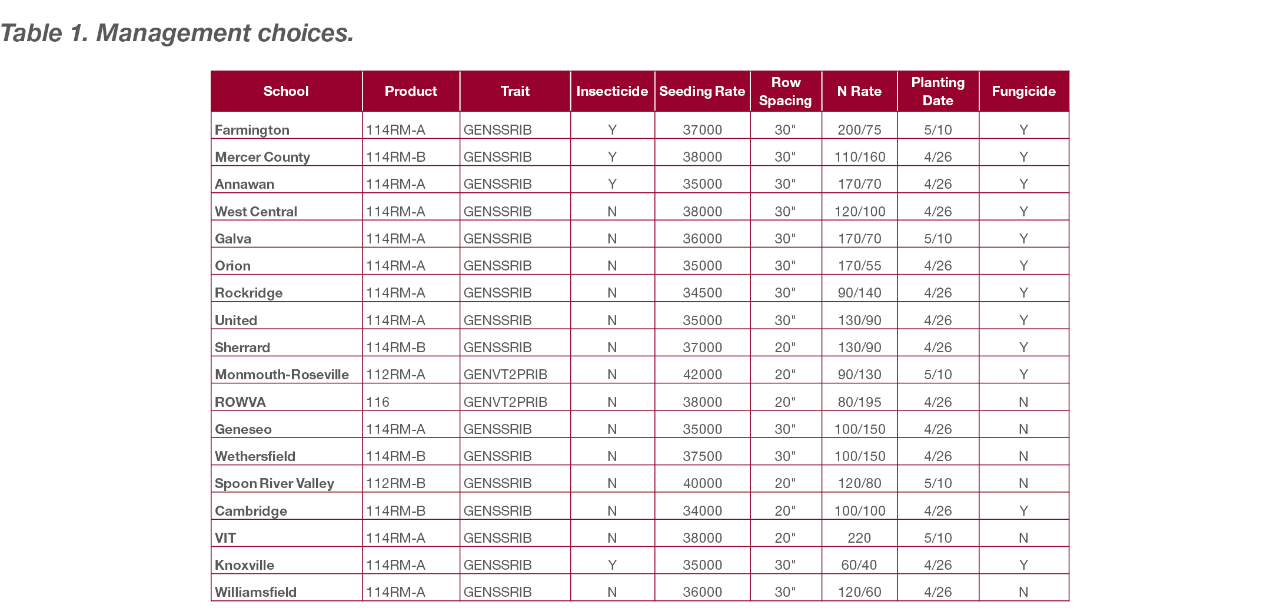Trial Overview
- In 2013, the Monmouth Learning Center created an educational competition for area high school agriculture programs. Since then, the Fantasy Farming Challenge has grown each year. In 2018, we had 18 participating schools from Illinois, providing an opportunity for hundreds of students to learn more about crop production and the agriculture industry.
- In February, students in the participating schools attended a presentation where they learned about basic corn production, the key decisions a grower must make every season, and the risks and costs associated with those decisions. From there, the students were required to design a corn plot and make the following key decisions:
— Select a corn product from a list of several different genetic families and trait packages
— Whether to add a soil insecticide
— Planting date (early, mid, or late)
— Seeding rate
— Row spacing (20 inches or 30 inches)
— Pounds of nitrogen per acre
— Timing of nitrogen application (all applied pre-plant, or split between a pre-plant and in-season application)
— Whether to apply a foliar fungicide
- Once their decisions were submitted, the Learning Center staff planted each school’s plot, implementing all the choices the students made. During the season, each school took a field trip to the Monmouth Learning Center to see their plot and learn more about agronomy as well as career opportunities in the industry.
- At the end of the season, all plots were harvested, yields were adjusted to 15% moisture, and the grain was sold on the cash market. There were two prizes given out: one was awarded to the school who produced the highest yield, and one was awarded to the school who returned the highest profit based on their decisions.

Objective
- To demonstrate to students that their agronomic management decisions impact both yield and economic return.
Research Site Details

Understanding the Results
- Corn rootworm (CRW) management was a key factor in these trials. The two schools who did not employ CRW control measures produced the lowest yields out of all schools. Noticeable root lodging was evident in these plots (Figure 4).
- Nitrogen management also made a difference this year. Schools that chose higher nitrogen rates at the pre-plant application tended to yield and perform better. Reducing nitrogen rates resulted in much lower productivity.
- The yield separation from the 4th through 7th place schools was 3.4 bu/acre, but were separated by as much as $52/acre in net profit. The highest yielding plot ranked 7th regarding profitability. Similarly, the most profitable plot was not the one with the lowest cost per acre. Those students did not cut back on seed or nitrogen costs. The Net Profit was calculated based on each schools total profit from yield minus input costs.
- These are excellent lessons for students in that the goal of a farmer is not just to produce high yields, but to do so efficiently.




Congratulations to the students at Mercer County High School in Aledo, IL for putting together the highest yielding plot! Congratulations to the students at Wethersfield High School who designed the most profitable plot! Thank you to all schools who participated, and we look forward to conducting this competition again in 2019!
What Does This Mean for Your Farm?
- Farmers must evaluate each agronomic and financial input that they can control as well as costs and production risks that are out of their control prior to planting a crop to help establish a crop production budget with a realistic projection of net income/acre.
